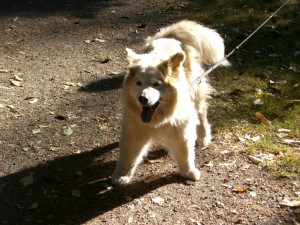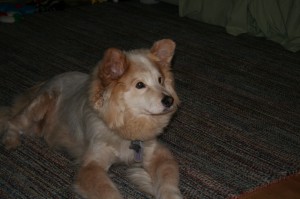Xiao Chai Hu Tang – herbs to fight cancer – reversing triple burner obstruction
Saturday, April 9th, 2011 Moving into some of my favorite formulas, the ones I get to make from my own pharmacy!
Moving into some of my favorite formulas, the ones I get to make from my own pharmacy!
I love making herbal formulas from scratch!
First in this list is an amazing little formula I have used for a variety of conditions. When this formula fits it has the ability to reverse symptoms in some animals who are clearly shutting down and dying.
Xiao Chai Hu Tang is a traditional Chinese herbal formula also called Minor Bupleurum Decoction. One of my main uses of this formula is for cancer. In addition I have used it for some forms of liver failure and inflammation, inflammatory kidney disease and failure, disc disease, Addison’s disease, certain autoimmune diseases, gastrointestinal disorders, some forms of incontinence and hind leg weakness and some stress related diseases.
Xiao Chai Hu Tang is made from a combination of seven Chinese herbs:
Chai Hu (bupleurum)
Gan Cao (licorice)
Huang Qin (skullcap)
Ban Xia (pinellia)
Sheng Jiang (ginger root)
Ren Shen (ginseng)
Da Zao (jujube)
This formula is one of the most researched in the world for cancer.
Bupleurum, the main ingredient in this formula, has some amazing cancer fighting abilities. Bupleurum can induce apoptosis or cell death in cancer cells and inhibit cancer cell growth and division. Many studies have been done on this plant especially for lung cancer.
Xiao Chai Hu Tang, called Sho-saiko-to in Japan, has been found effective for lung, liver, renal and prostatic cancers in humans. Xiao Chai Hu Tang directly kills cancer cells, inhibits the formation of blood supplies to these abnormal cells and induces apoptosis. It also stimulates the immune system and the body’s natural responses against cancer.
This is a very powerful but fairly gentle formula. It supports digestion through it’s use of pinellia, ginger, and licorice. In addition, licorice, jujube, and ginseng help support adrenal and immune function in the body.
It is commonly used to treat the Chinese medicine diagnosis of Triple Burner Obstruction (TBO).
Triple Burner what?
I’ll try to go into this a little deeper later but for now here’s a short explanation.
The triple burner in Traditional Chinese Medicine runs down the center line of the body. There is the upper burner which includes the lungs and heart, middle burner with the spleen and liver, and lower burner with the kidneys and urinary bladder.
 If the triple Burner is obstructed, yin and yang can not meet and there is a separation of yin and yang in the body. The yin or water of the kidneys needs to come up and cool and mist the lungs and heart, and the yang or fire of the heart needs to descend down and spark the fire of life of the kidneys.
If the triple Burner is obstructed, yin and yang can not meet and there is a separation of yin and yang in the body. The yin or water of the kidneys needs to come up and cool and mist the lungs and heart, and the yang or fire of the heart needs to descend down and spark the fire of life of the kidneys.
When yin and yang come together you get life. Both these functions happen by passage through the triple burner along the center line of your body. If these functions can not happen, the upper body gets hotter and the lower body gets weaker. If yin and yang can not meet then the body stops working.
Here is another way to look at it. If you look at yang as the chemical reactions in the body which fuel life, and yin as the antioxidant response that makes sure no harmful products are left behind, you can understand how these two relate. You need both for life and you need them to work together. Without the yin antioxidant response we become toxic, without the yang fueling the body we become weak and deficient. If either of these functions stop we are in trouble.
Triple burner obstruction will lead to death – sometimes very quickly, if the obstruction is complete and sudden and sometimes over a longer time, if it happens slowly.
Triple burner obstruction commonly manifests with excess conditions in the front of the body such as coughing, vomiting, anxiety, headache, and/or panting and deficiency or weak conditions in the back of the body such as hind leg weakness and incontinence. There is usually some kind of obstruction in the middle of the body such as a tumor in the liver or spleen, bloated abdomen or back pain.
In western medicine we would characterize triple burner obstruction as being a problem with blood flow, where there is too much blood in the front of the body, not enough in the back, and a pooling or stagnation of blood in the middle. Splenic tumors often fit this pattern because of the amount of blood that gets trapped in the spleen.
Cancers with symptoms of triple burner obstruction often respond well to Xiao Chai Hu Tang. Mostly I use this formula for many cancers with lung metastasis, chest tumors and abdominal tumors especially splenic tumors and lymphoma/lymphosarcoma. However any animal with signs of triple burner obstruction should be put on this formula.
This is a very important formula in my cancer medicine chest. Many of the animals I treat would not be here without it. A good example is Lou. We put him on this formula when he started to decline and were able to get him back to health with it in a matter of days.
Where do you get Xiao Chai Hu Tang and how do you give it?

Xiao Chai Hu Tang powder is now available from my shop Kingdom of Basil on etsy.com .
I grind my own formulas from good quality dried whole herbs. This formula works best if given in the evening mixed with food. I usually give my larger dogs 1 teaspoon once a day with dinner, dogs less than 50 lbs get ½ a teaspoon and dogs less than 20 lb get ¼ a teaspoon and very small dogs and cats get 1/8 teaspoon.
For cats I usually tincture this or have people make it into a tea. To tea, just add 1 teaspoon of herbs to a cup of water and boil until half the liquid is gone. Then give the same amount you would of the dry herbs. If you can use a prepared tincture, you can give .2ml per 5 lbs of body weight.
If you use another commercial formula make sure it contains Ren Shen – ginseng and not Dang Shen. Also make sure it does not contain more than 20% Chai Hu or bupleurum. Many of the human formulas are very heavy on Chai Hu, the traditional recipe uses it at about 20% of the formula. Preparations with more than 20% Chai Hu can be very dangerous to your animal’s health.
Here is some more information and a list of studies involving this formula
Memorial Sloan-Kettering Cancer page on Xiao Chai Hu Tang
Memorial Sloan-Kettering Cancer page on Bupleurum
As always please check with your animal’s regular vet before using this formula.
Return to Integrative and Holistic Methods for Treating Cancer in Cats and Dogs.
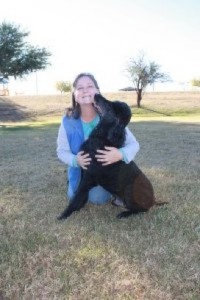
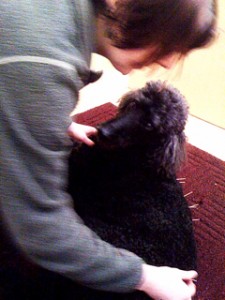

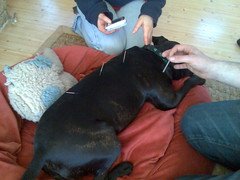

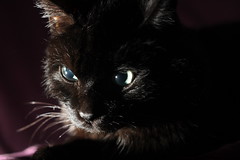
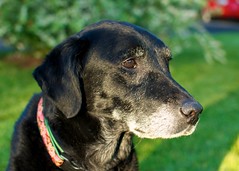
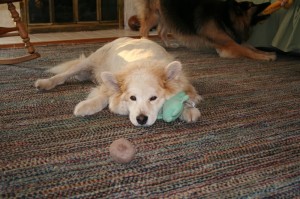
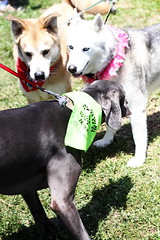
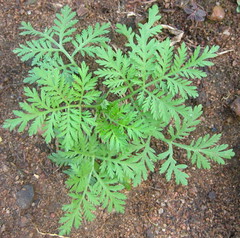


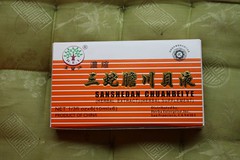 SanSheDan ChuanBeiYe is one of my primary herbals I use for cancer treatment. It is a Chinese product marketed for use as cough syrup and contains three herbal/animal ingredients in a sugar solution. The primary ingredient in SanSheDan is apricot seed or Xing Ren. It also contains fritillary bulb (Chuan Bei Mu) and snake bile.
SanSheDan ChuanBeiYe is one of my primary herbals I use for cancer treatment. It is a Chinese product marketed for use as cough syrup and contains three herbal/animal ingredients in a sugar solution. The primary ingredient in SanSheDan is apricot seed or Xing Ren. It also contains fritillary bulb (Chuan Bei Mu) and snake bile.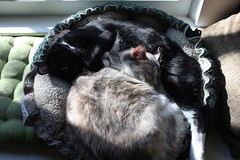 I have never had an animal have a negative reaction to this product at this dose.
I have never had an animal have a negative reaction to this product at this dose.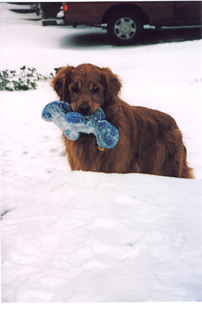 Maggie tries really hard to be a good guard dog. When you come to the door of her home, you can hear her barking in a strange muffled way, which makes you wonder until the door is opened and you realize she has a teddy bear in her mouth. That being said Maggie loves people and once she meets you she is all smiles, teddy bear or no teddy bear. Maggie has a way of smiling with her eyes that just draws people in.
Maggie tries really hard to be a good guard dog. When you come to the door of her home, you can hear her barking in a strange muffled way, which makes you wonder until the door is opened and you realize she has a teddy bear in her mouth. That being said Maggie loves people and once she meets you she is all smiles, teddy bear or no teddy bear. Maggie has a way of smiling with her eyes that just draws people in.
